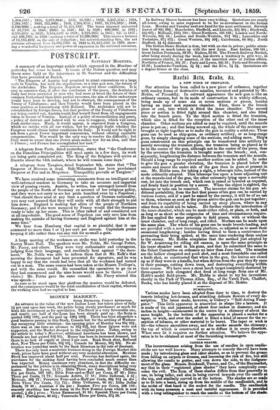Wistful rto, trap. &r.
A NEW PIECE OP ORDNANCR.
Our attention has been called to a new piece of ordnance, together with sundry forms of destructive missiles, invented and patented by Mr. Hobbs, of Piccadilly. In outward appearance the new gun is like an ordinary cannon, but in its mode of construction it is widely different, being made up of some six or seven sections or pieces, besides having an inner and separate chamber. First, there is the breech piece or end, into which is fitted the inner chamber. The second piece or section is fitted tight around this chamber, and also fitted into the breech piece. To the third section is fitted the trunnion, which also is fitted for the reception of the other end of the inner chamber. Other sections are added as may be required, until the muzzle piece is put on ; and that being screwed up, the whole of the sections are brought so tight together as to make the gun in reality a solid one. These guns can be used as ship-guns, as ordinary artillery, or as long-range guns, by simply changing some of the sections, and adding more. Ship's guns constructed on this principle can be transferred into artillery by merely reversing the trunnion piece, the trunnion being so placed as to be in the centre of the gun, although not in the centre of the piece, thus by the reversion the trunnion is brought nearer the breech ; and, con- sequently, lengthening the distance between the trunnion and the muzzle. Should a long range be required another section can be added. In order to give the gun a greater elevation, the trunnion is placed below the centre and nearer the under side of the gun than in guns at present in use. Mr. Hobbs uses, for taking a sight, a telescopic tube, instead of the mode ordinarily adopted. This telescope lies upon a loose adjusting rest at the muzzle-end of the gun, the other extremity lying upon a moveable rest, let into the breech end, which rest is raised or lowered as required, and firmly fixed in position by a screw. When the object is sighted, the telescope or tube can be removed. The inventor claims for his gun ad- ditional portability, from the fact that pieces of his gun can be carried by various routes, and if a part be seized by the enemy, it will be of no use to them, whereas as soon as the pieces arrive the gun can be put together; and from its capability of being carried up steep places, where in any other form it could not be taken. He further claims the introduction of the inner chamber, which can be made either rifled, or plain, or both, and as long or as short as the exigencies of time and circumstances require. He has applied the same principle to field pieces, with or without the inner chamber, and of long range, and rifled. Mortars can be made upon the same plan. The whole of his guns can be made breech-loading, and are provided with a new traversing platform, so adjusted as to meet their occasional lengthening ; besides having fitted to them a contrivance for preventing their being spiked, at the same time rendering them useless to the enemy. Mr. Hobbs complains that the method just adopted by Sir W. Armstrong for rifling old cannon, is upon the same principle as his inner chamber used in his guns, and that he submitted the same to the Select Committee on ordnance no later than June last. The missiles are the hollow elongated and puck shot, and a most formidable one called a knife shot, so constructed that when in the gun, the knives are closed up as if they were in a handle, but when driven from the gun they fly open in their passage, cutting down trees, and destroying everything within their course. We have seen a stout beech target completely shattered by three-quarter inch elongated shot fired at long range from one of Mr. Hobb's model field-pieces. Mr. Hobbs is about to try his inventions shortly in the Park of Thomas Allen, Esq., of the Vetch Park, Chalfort, Bucks, who has kindly placed it at the disposal of Mr. Hobbs.


























 Previous page
Previous page